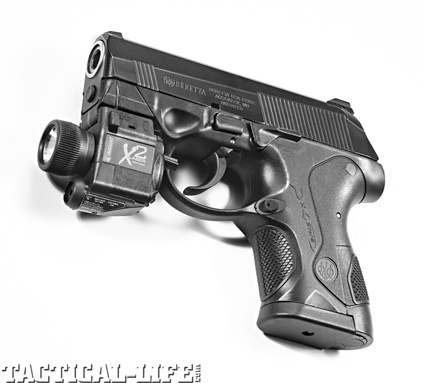The Beretta PX4 Storm Subcompact 9mm is built around modular technology, delivering concealed carry handling with large frame firepower. Seen here with Insight X2L laser/light combo.
In many quarters of law enforcement and the law-abiding armed citizenry that old stand-by concealed carry gun, the snub-nosed .38 revolver, is being replaced by subcompact pistols chambered for the 9mm. Their siren song of more bullets and less recoil in a package of similar size and weight is hard to resist.
Beretta realized early on that their classic 9mm pistol, the exhaustively proven Model 92 that for a quarter century has served the US military all-service-wide as the M9, did not mechanically lend itself to a chop-and-channel size reduction that would bring it down to sub-compact dimensions. However, the Beretta PX4 Storm Subcompact 9mm that qA introduced a few years ago, most certainly did, and the Sub-Compact variation of the PX4 Storm hit the US market in 2008.
Advertisement — Continue Reading Below
With a polymer frame that both reduces weight and reduces cost at both the manufacturer’s end and the buyer’s, the PX4 Storm is priced to compete with other “plastic pistolas.” Those for the most part are striker-fired. The Storm is storming that market by attacking the niche that likes the older style hammer-fired autopistols. Why would there be such a niche at all? Well, (1) the Storm’s design allows second strike on a recalcitrant primer with another simple pull of the trigger, and most striker-fired handguns don’t. (2) The external hammer allows the shooter to holster with the thumb on the hammer, preventing its rise and subsequent fall if anything catches the trigger and pushes it back – something like the too-narrow safety strap on a poorly designed holster, or the drawstring of a concealing warm-up jacket, or the shooter’s own finger, all of which have been documentably known to cause un-intentional discharges during holstering.
Beretta PX4 Storm Subcompact 9mm Details
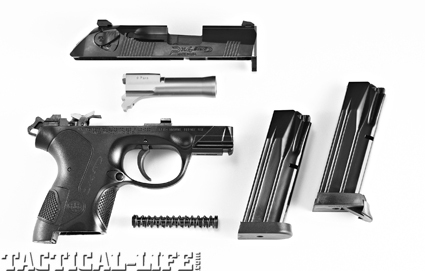
The PX4 Storm Subcompact disassembles very easily and quickly into five parts, of course, not counting the spare mag.
Advertisement — Continue Reading Below
The Beretta PX4 Storm Subcompact 9mm system has been offered in four formats. The “C” style is double-action-only, very light and smooth, Beretta’s answer to the light, controllable DAK system offered by Sig Sauer and the similar LEM option from Heckler & Koch. The “D” style is double-action-only with a long, heavy pull, which I personally don’t like as well as the “C” option. Both of these are “slick-slide-guns” with no levers on the slides. Beretta also catalogs a “G” option, in which only the first shot is double-action and the subsequent shots will be fired from an automatically-cocked single-action platform. It mounts a spring-loaded slide lever that serves as a decocker only.
Finally, there is the “F” series, traditional double-action first shot with combination safety and decocking lever. The only format I have thus far actually put my hands on is a PX4 Sub-Compact. It is the format in which Beretta prefers to sell to the civilian market. Double-action-only systems like the “C” and “F” never sold well to anyone but liability-conscious folks, who generally come from the institutional markets of the law enforcement services and corrections. Our test gun for this article was a PX4F Sub-Compact.
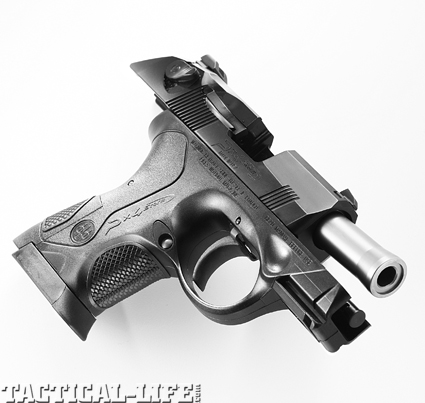
Advertisement — Continue Reading Below
The Beretta PX4 Storm Subcompact 9mm uses a reliable locked breech and tilt barrel system, providing a more compact and lighter weight system.
Double-action trigger pull on our test gun averaged 9.96 pounds on my Lyman digital trigger pull gauge, and was consistent from first pressure to the shot without significant “stacking,” or increase in resistance as the trigger came farther back. In single-action mode, the same device showed an average pull weight of 4.84 pounds. As the shooter behind the sights, I couldn’t feel any significant “backlash” on the trigger after each shot broke. Sear release was clean and crisp. I’d quantify the re-set distance of the trigger for follow-up single-action shots as medium in length, and definitely controllable.
The Beretta PX4 Storm Subcompact 9mm differs from Beretta’s classic 92F in that the 92F has one of the slickest, fastest-working safety catches in the history of slide-mounted safety/decock levers. The first service-size PX4s had a differently shaped lever that was pointy toward the front (chewing up fingers in fast and furious clearance drills), and neither was so fast nor so easy to operate as the levers on 92s and M9s. The smaller size of the Px4 may be the reason that, at least in this writer’s hand, the safety releases more easily on the Sub-Compact than on the full-size Px4. I find I can catch it nicely either with a 45-degree upward thrust with a straight thumb or with the middle joint knuckle of a curved thumb. This is highly dependent on the size and shape of the shooter’s thumb, however.
Advertisement — Continue Reading Below
Personally, on the full-size Beretta PX4 Storm Subcompact 9mm, I’m inclined to the slick-slide “C” variation; as much as I like to have the option of an on-safe gun, I think it passes the point of diminishing returns if the shooter can’t quickly and reflexively off-safe it on the draw. That seems to be a bit less of a problem with the Sub-Compact size PX4. And I have to say that over the years, I’ve seen countless cases where someone got the good guy’s gun away and tried to shoot him with it, but failed because the gun was on-safe, and no cases of trained people getting shot because they failed to off-safe their own pistol when they fired in self-defense. I did find one case of an untrained man who was shot and wounded because he forgot to off-safe a pistol of another brand, which he had not trained with. When asked why he hadn’t drilled with the “safety off, pull trigger” protocol, his reply was something like, “I’m not Rambo, all right?”

Advertisement — Continue Reading Below
The PX4 Sub-Compact in 9mm takes the same 13 + 1 cartridge capacity that those of my generation grew up finding only in the service-size Browning Hi-Power. It’s still more than you’ll find in most polymer sub-compact 9mm pistols today. The magazines are tough to load to full capacity, but that’s something you have plenty of time to do before you load it up to carry it. I see the high capacity as a plus, and the time it takes to load the magazine as no big deal in a “carry gun.” However, when the magazine is fully loaded, it locks easily into the grip-frame without resistance, unlike many other autopistols when their magazines are loaded all the way up. That’s a definite “plus” for the Px4 Sub-Compact 9mm.
I can point to a couple of features on this little gun that can be a “life- saver” in one case and can be a “career and future saver” in another. The lifesaver in a fight will be its “standoff capability.” Most autopistols, when shoved into the attacker’s body at belly-to-belly, shoot-or-die distance, will “go out of battery” and fail to fire because the barrel slide assembly has been pushed too far back. The PX4 Sub-Compact won’t, at least when pushed straight in against the opponent, or upward against him. The slightly protruding length of the recoil spring guide rod keeps that from happening. If you’re pushing down-ward, though, it can go out of battery. This is a very significant advantage to the PX4 Sub-Compact.
The full-size PX4 has a Glock-like takedown with twin levers in niches on the side. In the reduced-size model, there isn’t room for that internally, so there’s a separate lever for takedown…but the niches remain. This leaves an excellent “felt index spot” for the trigger finger in the “ready position,” to keep it the hell out of the triggerguard until the shooter is in the very act of intentionally firing the weapon. I for one, having been an expert witness in all too many cases of unintentional shootings of human beings over the last 30 years, think this feature is a good thing.
Advertisement — Continue Reading Below
Shooting Impressions
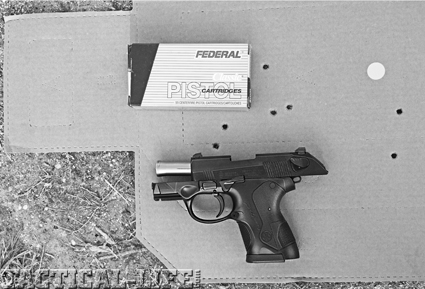
PX4 Sub-Compact didn’t give the author the tight groups he normally gets from a Beretta 92. This was best of test, with 115-grain Federal 9 BP standard pressure hollow point.
The PX4 shares the rotary breech design of the 8000 series Berettas that preceded it. One reason for that design was slowing the recoil impulse. I have to say — it works. Most anyone who shoots a PX4 of any size comments on the soft recoil for the size and caliber, and the PX4 Sub-Compact is no exception.
Advertisement — Continue Reading Below
Nothing on this gun bites the hand on recoil. You’d think with the bore axis as high as it is, would kick back into the hand more and jump more at the muzzle. It simply doesn’t. I have to assume the rotary breech thing is what’s softening the gun’s movement upon discharge.
The short grip-frame only allows two fingers to take a really solid grasp in the bare hand, with the index finger deployed to work the trigger. I found myself tucking the pinkie finger under the butt to help stabilize, which actually worked pretty well.
I ran this one off the bench with 147-, 124, and 115-grain 9mm rounds by the “big three makers” on a day when I was shooting 2 inches or better with service-grade handguns, and the little 9mm just didn’t make the cut in my hands. Every load shot very low and somewhat right. Remington 124-grain +P Golden Saber put five shots in 6.15 inches, strung mostly vertical with the best three in only 4.20 inches; Winchester subsonic 147-grain FMJ did 4.80 inches for all five with the best four in 3.65 inches, and the best three in 2.25 inches; and the “best of test” Federal 9BP 115-grain hollow point went 4.15 inches for all five and 2.10 inches for best three. The distance was 25 yards.
Advertisement — Continue Reading Below
I’ve found over the years that the “best three” hand held from the bench compensates for human error, which is why I include that measurement. Still, I’ve been spoiled by Beretta 92 pistols that out of the box went between 1 and 2 inches for all five shots, and am not happy with these results. In per-spective, though, the five-shot groups would all have been inside the maxi-mum point-scoring zone of any police qualification target at the same distance.
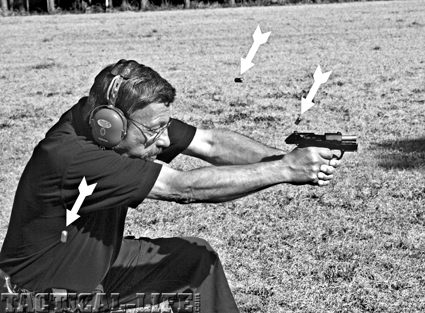
Author found the PX4 9mm soft-kicking and controllable. At end of a burst of rapid fire, the Subcompact Storm locks open empty but still on target, with three spent casings (arrows) still in the air.
Reliability, obviously, comes before accuracy in a defensive handgun. A test team of several competent shooters joined me in running several hundred rounds through the last PX4 I tested. The result? Zero malfunctions. This particular specimen didn’t get as many rounds, but it still never jammed. I’ve seen the PX4 Sub-Compact go through everything from qualification courses to 500-round shooting classes to 120-shot IDPA matches over the last year and a half plus, and have not yet seen one jam. That collective experience leaves me comfortable with the reliability of the 9mm PX4 Beretta Sub-Compact in general. The only malfunctions I’ve seen have been “shooter-induced;” if you fire with a forward thumbs position, the thumb(s) may ride down the slide stop lever and prevent the slide from locking open on the last shot. That’s “on the shooter, not on the gun,” in this reviewer’s opinion. We see the same thing happen with many other makes and models of semi-automatic pistols.
Final Notes
Let’s see…it functions reliably. It is compact. It can be had with a manual safety that buys the owner some time to deal with the horror of being disarmed by his or her attacker. It holds more rounds than most of its competition and comes back on target very quickly, with a very soft felt recoil impulse. At muzzle contact distance, it’s more likely to keep working than most of its competition. It also has interchangeable grip backstraps to adjust size and fits many hand sizes well as it comes from the box. It doesn’t have the accuracy we competitive shooters like. It may take a little extra effort to load its magazines up to full cartridge capacity.
All things considered, the Beretta PX4 Storm Sub-Compact 9mm has way more going for it than against it, and is a very promising pistol for someone who needs a concealable handgun that will deliver the life-saving goods in an up-close-and-personal confrontation. For an “all around use” Beretta, I’ll stay with one of my Model 92s, but for a high-capacity 9mm “belly gun,” the PX4F Storm definitely passes the acceptance test.
